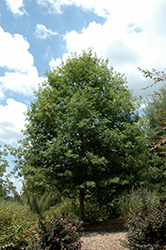It's all about ...
plants

Highpoint Nuttall's Oak
Quercus nuttallii 'QNFTA'
Height: 40 feet
Spread: 25 feet
Sunlight:
![]()
Hardiness Zone: 6b
Other Names: Texas Red Oak
Description:
A beautiful and artistic shade tree with a pyramidal shape and good orange-red fall color; a perfect shade or street tree; tolerates clay or wet soils, prefers loose, slightly acidic soils
Ornamental Features
Highpoint Nuttall's Oak has dark green foliage with light green veins on a tree with a pyramidal habit of growth. The glossy lobed leaves turn an outstanding antique red in the fall.
Landscape Attributes
Highpoint Nuttall's Oak is a deciduous tree with a distinctive and refined pyramidal form. Its average texture blends into the landscape, but can be balanced by one or two finer or coarser trees or shrubs for an effective composition.
This tree will require occasional maintenance and upkeep, and is best pruned in late winter once the threat of extreme cold has passed. It is a good choice for attracting squirrels to your yard. Gardeners should be aware of the following characteristic(s) that may warrant special consideration;
- Messy
Highpoint Nuttall's Oak is recommended for the following landscape applications;
- Shade
Planting & Growing
Highpoint Nuttall's Oak will grow to be about 40 feet tall at maturity, with a spread of 25 feet. It has a high canopy with a typical clearance of 6 feet from the ground, and should not be planted underneath power lines. As it matures, the lower branches of this tree can be strategically removed to create a high enough canopy to support unobstructed human traffic underneath. It grows at a fast rate, and under ideal conditions can be expected to live to a ripe old age of 300 years or more; think of this as a heritage tree for future generations!
This tree should only be grown in full sunlight. It is quite adaptable, prefering to grow in average to wet conditions, and will even tolerate some standing water. It is not particular as to soil type, but has a definite preference for acidic soils, and is subject to chlorosis (yellowing) of the foliage in alkaline soils. It is highly tolerant of urban pollution and will even thrive in inner city environments. This is a selection of a native North American species.
This plant is not reliably hardy in our region, and certain restrictions may apply; contact the store for more information.
